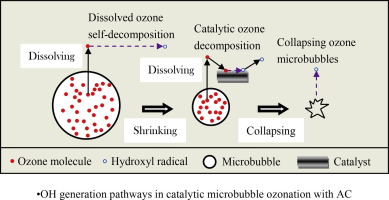Separation and Purification Technology ( IF 8.6 ) Pub Date : 2018-02-27 , DOI: 10.1016/j.seppur.2018.02.003 Jing Zhang , Guo-Qing Huang , Chun Liu , Rui-Na Zhang , Xiao-Xuan Chen , Lei Zhang

|
The performance of catalytic microbubble (MB) ozonation using a commercial granular activated carbon (AC) as catalyst in synthetic acid red 3R wastewater treatment was more efficient than that of coarse bubble (CB) and MB ozonation alone. The ozone mass transfer coefficient, ozone decomposition coefficient, decolorization rate constant, TOC removal rate constant, and ozone reaction efficiency achieved in catalytic MB ozonation were 0.253 min−1, 0.093 min−1, 0.342 min−1, 0.0242 min−1 and 0.128 mg(TOC removed)/mg(ozone consumed), respectively. The average ozone utilization efficiency in catalytic MB ozonation was as high as 98.3%. The synergistic effect of collapsing ozone MBs and catalytic activity of AC enhanced hydroxyl radicals (OH) oxidation in catalytic MB ozonation which provided about 75% of oxidative capacity for TOC removal, even at a low pH. The enhanced
OH oxidation was crucial for the mineralization of acid red 3R in catalytic MB ozonation where some
OH scavengers could make TOC removal less efficient, especially Na2CO3. In addition, the catalytic activity of this commercial AC seemed stable after five recycling cycles. UV–Vis spectra and GC–MS analyses indicated that acid red 3R was oxidized-degraded by a pathway of azo bond cleavage, formation of naphthalene- and benzene-type compounds, further generation and final mineralization of small organic acids, which initially reduced the pH and increased the value again during catalytic MB ozonation. Therefore, the catalytic MB ozonation with commercial granular AC was a promising solution for wastewater treatment by ozonation process.
中文翻译:

微泡与活性炭协同作用对合成印染废水的臭氧处理
使用市售粒状活性炭(AC)作为催化剂在合成酸性红3R废水处理中的催化微气泡(MB)臭氧氧化性能比单独的粗气泡(CB)和MB臭氧氧化性能更高。臭氧传质系数,臭氧分解系数,脱色速率常数,TOC除去率恒定,并且在催化MB臭氧化实现臭氧反应效率均0.253分钟-1,0.093分钟-1,0.342分钟-1,0.0242分钟-1和0.128毫克(去除TOC) /毫克(消耗的臭氧), 分别。催化MB臭氧化中的平均臭氧利用效率高达98.3%。崩溃的臭氧MBs和AC的催化活性的协同作用增强了催化MB臭氧化反应中的羟基自由基(OH)氧化,即使在低pH值下,TOC去除的氧化能力也约为75%。增强的
OH氧化对于催化MB臭氧氧化中酸性红3R的矿化至关重要,在该过程中,某些
OH清除剂会使TOC去除效率降低,尤其是Na 2 CO 3。另外,该商业AC的催化活性在五个循环循环后似乎稳定。UV-Vis光谱和GC-MS分析表明,酸性红色3R通过偶氮键裂解,萘和苯型化合物的形成,进一步生成和最终矿化的小有机酸的途径被氧化降解,这最初还原了pH值,并在催化MB臭氧化过程中再次增加该值。因此,用商业颗粒状AC催化MB臭氧化是一种通过臭氧化工艺处理废水的有前途的解决方案。


























 京公网安备 11010802027423号
京公网安备 11010802027423号